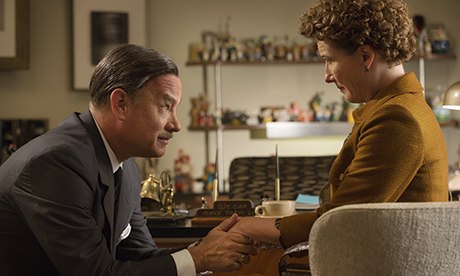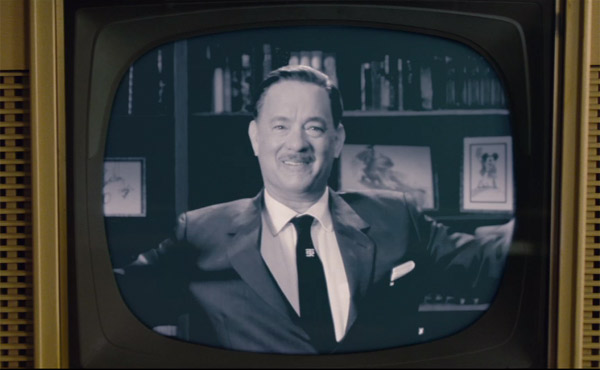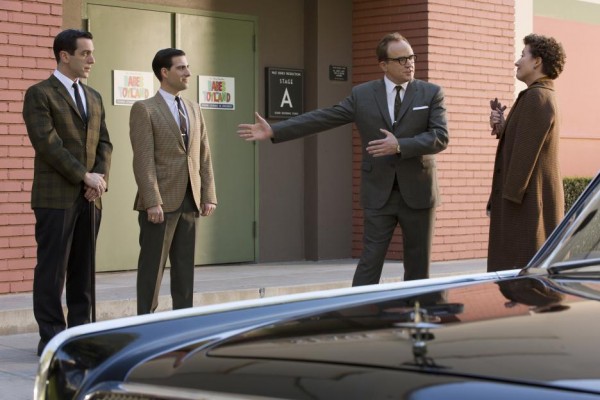It’s hard to imagine a world without Mary Poppins. The film has become such an ingrained part of popular culture that kids know who the flying nanny is even without having seen the film, and they know that just a spoonful of sugar will help the medicine go down. Many people, however, probably don’t know that Mary was dreamt up by Helen Goff, or as she was more famously known, P.L. Travers. The magical nanny appeared in 8 books, telling her tales looking after the Banks family and their subsequent adventures.
Saving Mr. Banks is a film that focuses on the strange relationship between Travers and Mr. Walt Disney who desperately wanted to make a film out of her books. From a script that was included on the 2011 Black List (a list of the best unproduced scripts) the film sets out to examine how the famous film came to be, and more importantly how it almost didn’t happen at all. When his daughters were young, Walt Disney discovered their favorite book was about a British nanny named Mary Poppins, and he declared that he would bring her to life. He then spent 20 years trying to convince Travers to give him the rights. She of course had no desire to sell, and only gave in to his requests to meet when her royalties from the books ran out. The film picks up here, following Travers from England to Los Angeles, as well as dipping into her past as it flashes back to her childhood in Australia.
Emma Thompson plays Travers, and has to walk a fine line. Travers is a rather unlikable figure, being extremely rude and unruly to everyone around her as she deals with Hollywood attempting to adapt her character. Thompson digs deep trying to find the reason for this prickly demeanor and brings out the underlying sadness and unhappiness in the character. Playing against her is Tom Hanks as Walt Disney. Hanks is the first person to inhabit the person of Uncle Walt since Walt himself, and it’s nice to see that he doesn’t try to do a ridiculous impersonation in terrible makeup, but rather lets his own charming persona inhabit the charismatic figure that we all know from the television and film reels.
Of course, this film could have easily been a platform on which to worship at the golden idol of Walter Elias Disney, but interestingly Disney doesn’t do that. There is a restraint that surprises me in this film, and the film even shows Walt doing things that have historically been ignored Walt was a smoker and died of lung cancer, and the film shows him smoking and coughing his way to the grave. It shows him drinking, cursing (in a PG way, but still) and even being manipulative and sneaky when it suited him. The film doesn’t delve into things that I am sure some would like to see get out (His racism and sexism goes untouched on, to the surprise of no one.) but making Walt human is the last thing I expected Walt Disney Pictures to allow, and yet here it is. At one point in the film, he decided not to invite Travers to the LA Premiere of the film because he doesn’t want her talking to the Hollywood press. It’s a choice that bites him in the ass, and the film doesn’t seek to polish it and make it look like the right choice. Part of the restraint possibly comes from the fact that this is more Travers’ story than Disney’s.
The film is at it’s best when it’s in Hollywood, showing the tense meetings between Travers and the screenwriter (a wonderfully befuddled Bradley Whitford) and the songwriting Sherman Brothers, Robert (BJ Novack) and Richard (Jason Schwartzman.) Thompson plays off these actors in wonderful ways, and her awfulness as Travers is more amusing than annoying when she spars with them over things like made up words, the design of the Banks residence and the use of the color red. Some of the film’s best moments happen in the rehearsal room, especially the moment where the Shermans present her with Let’s Go Fly A Kite after her request for Mr. Banks to be made more sympathetic. It’s the character work that makes this film shine. Schwartzman is a prime example. His charm as Richard Sherman is infectious and he performs some of the songs with aplomb. Another great character is Paul Giamatti’s Ralph, who is the driver hired by Disney to drive Travers around. At first, Travers shuns him, and ignores him, but by the end of the film, they develop a really wonderful little rapport that culminates in one of the film’s sweetest scenes.
The flashbacks to her in Australia are well made and acted, but overall, they fall a bit flat in most cases. This is a shame because Colin Farrell as Travers Goff is a wonderful performance. He plays a man who is torn between the family he dearly loves and the alcohol that is killing him and his career. This is where the film gets to throw in some clever nods to the original film, but the only time where the flashbacks really work is when one of the Sherman songs begins to work it’s way into a memory of her father drunkenly ranting on a grandstand. It’s one of the film’s most powerful moments, and it’s a shame the film doesn’t use the flashbacks to do more of that.
Hollywood “Biopics” about Hollywood tend to be self congratulating garbage that barely touch on the truth of the actual story, and while I am sure some of the edges of this tale are smoothed out to make it more palatable for a film audience (Travers was infamously a woman who no one enjoyed working with, and she often changed her tune about her overall feelings on the Mary Poppins film) but the film successfully tells a story about two storytellers who were so drastically different, and how they came together to craft one of the world’s most popular films. If you are like me, and you love the film Mary Poppins, this is a film that will entertain, and at times, break your heart, just a little.



